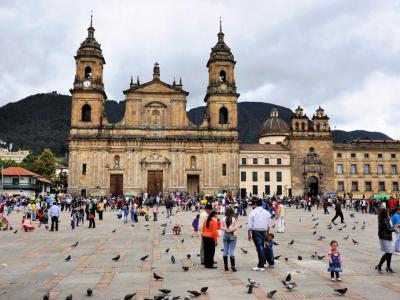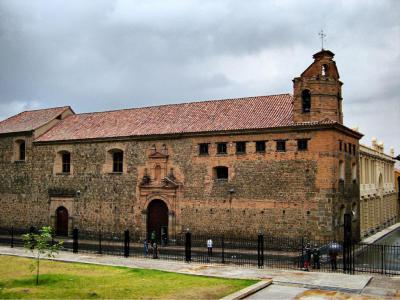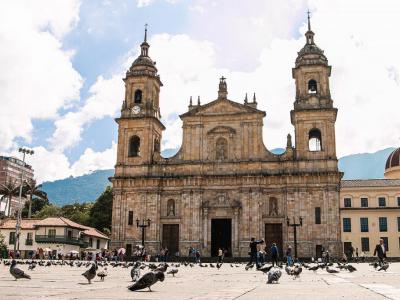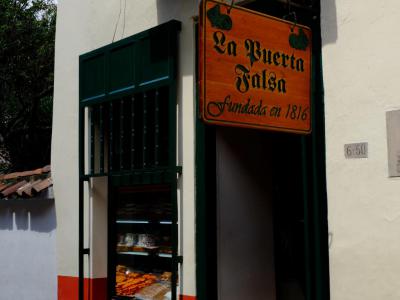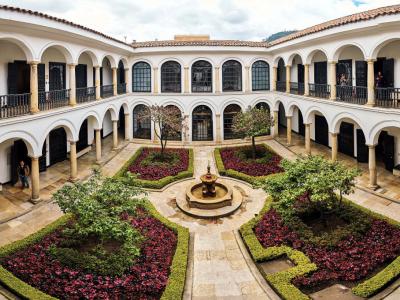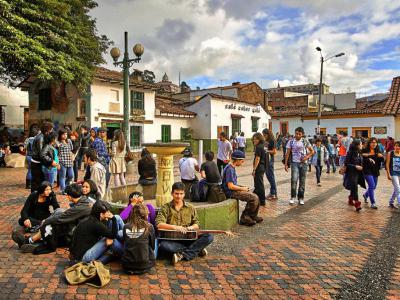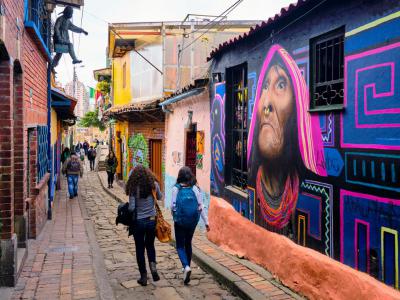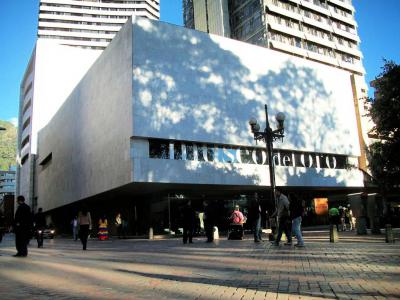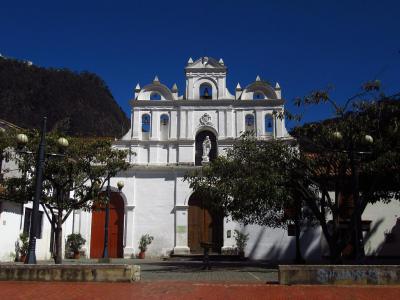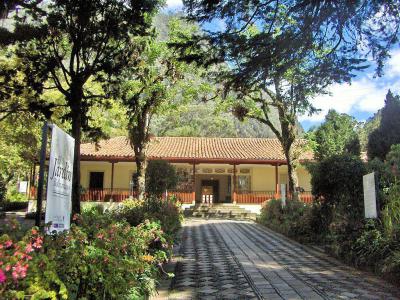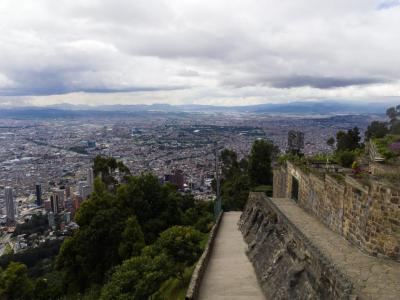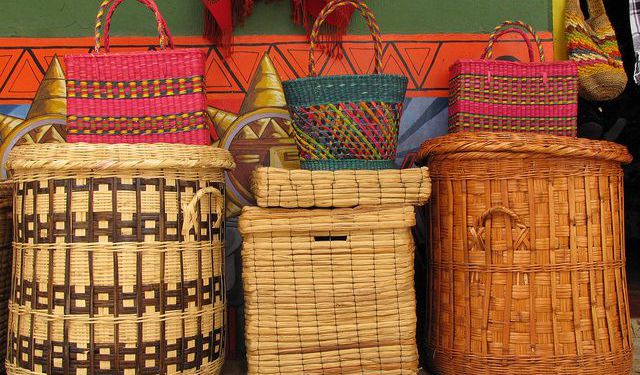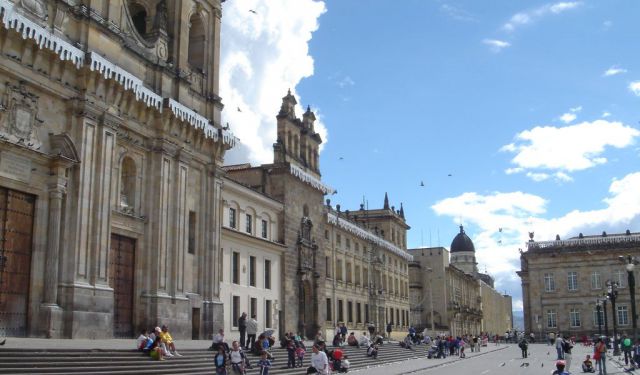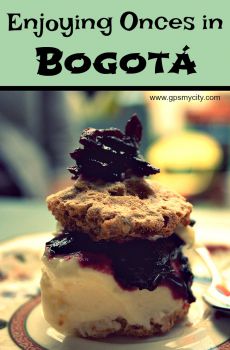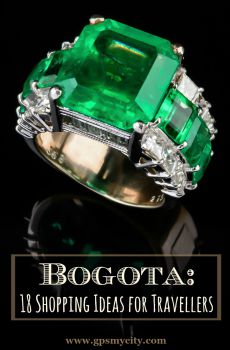
Bogota Old Town Walking Tour (Self Guided), Bogota
In 1538, the indigenous Muisca of the Colombian Altiplano had the advantage in numbers over the force of conquistador Gonzalo Jimenez de Quesada. Arriving in the Muisca Federation, the Spanish had only 162 exhausted men. However, the guecha warriors of Chief Tisquesusa were no match. The Federation fell in bloody battle.
In the area now known as Quevedo's Fountain Square, Quesada set up 12 reed houses and a church. He called the nascent city, "Our Lady of Hope." By 1575 the city was the capital of the Vice Royalty of New Granada.
Start a walking tour of old Bogota in the historic neighborhood of La Candelaria. Bolivar Square, the heart of the Bogota Old Town (also known as La Candelaria), holds the Primate Cathedral of Colombia, founded in 1539 by Gonzalo Jimenez de Quesada himself. The district of La Candelaria is named for the chapel of the Virgin of La Candelaria.
The old town is filled with colonial and republican style houses preserved and declared historical assets. Many have become theaters, like La Candelaria, Seki Sano, El Tecal, and Garcia Marquez. The best museums are here: Colonial, del Florero, Museum of Gold, Casa de la Moneda, Quinta de Bolivar, and the Botero Museum.
The Botero Museum has over 100 pieces by Colombian painter Fernando Botero and celebrated artists like Renoir, Monet, Degas, Picasso and Miro. The Luis Angel Library holds two million books and a vast art collection with works by Colombian and European artists. The Santa Clara Museum has Baroque and religious art of the 17th and 18th centuries.
What is a walking tour without food? La Puerta Falsa, founded by a fight with a priest, is the oldest restaurant in the city. Falsa has tamales extraordiaire, ajiacos, sweet deserts and legendary Santa Fe chocolate drinks. Casa Vieja, La Scala and Origen Bistro should also not be missed.
The cobbled streets of Bogota old town are filled murals, art and culture. Here one may fall in love with incomparable Bogota.
In the area now known as Quevedo's Fountain Square, Quesada set up 12 reed houses and a church. He called the nascent city, "Our Lady of Hope." By 1575 the city was the capital of the Vice Royalty of New Granada.
Start a walking tour of old Bogota in the historic neighborhood of La Candelaria. Bolivar Square, the heart of the Bogota Old Town (also known as La Candelaria), holds the Primate Cathedral of Colombia, founded in 1539 by Gonzalo Jimenez de Quesada himself. The district of La Candelaria is named for the chapel of the Virgin of La Candelaria.
The old town is filled with colonial and republican style houses preserved and declared historical assets. Many have become theaters, like La Candelaria, Seki Sano, El Tecal, and Garcia Marquez. The best museums are here: Colonial, del Florero, Museum of Gold, Casa de la Moneda, Quinta de Bolivar, and the Botero Museum.
The Botero Museum has over 100 pieces by Colombian painter Fernando Botero and celebrated artists like Renoir, Monet, Degas, Picasso and Miro. The Luis Angel Library holds two million books and a vast art collection with works by Colombian and European artists. The Santa Clara Museum has Baroque and religious art of the 17th and 18th centuries.
What is a walking tour without food? La Puerta Falsa, founded by a fight with a priest, is the oldest restaurant in the city. Falsa has tamales extraordiaire, ajiacos, sweet deserts and legendary Santa Fe chocolate drinks. Casa Vieja, La Scala and Origen Bistro should also not be missed.
The cobbled streets of Bogota old town are filled murals, art and culture. Here one may fall in love with incomparable Bogota.
How it works: Download the app "GPSmyCity: Walks in 1K+ Cities" from Apple App Store or Google Play Store to your mobile phone or tablet. The app turns your mobile device into a personal tour guide and its built-in GPS navigation functions guide you from one tour stop to next. The app works offline, so no data plan is needed when traveling abroad.
Bogota Old Town Walking Tour Map
Guide Name: Bogota Old Town Walking Tour
Guide Location: Colombia » Bogota (See other walking tours in Bogota)
Guide Type: Self-guided Walking Tour (Sightseeing)
# of Attractions: 11
Tour Duration: 2 Hour(s)
Travel Distance: 4.1 Km or 2.5 Miles
Author: Tom
Sight(s) Featured in This Guide:
Guide Location: Colombia » Bogota (See other walking tours in Bogota)
Guide Type: Self-guided Walking Tour (Sightseeing)
# of Attractions: 11
Tour Duration: 2 Hour(s)
Travel Distance: 4.1 Km or 2.5 Miles
Author: Tom
Sight(s) Featured in This Guide:
- Bolívar Square
- Museo Santa Clara (Santa Clara Museum)
- Catedral Primada de Colombia (Primate Cathedral of Colombia)
- La Puerta Falsa Restaurant (False Door Restaurant)
- Museo Botero (Botero Museum)
- Plaza Chorro de Quevedo (Quevedo's Fountain Square)
- Callejón Embudo (Bottleneck Alley)
- Museo del Oro (The Gold Museum)
- Iglesia Nuestra Señora de las Aguas (Church of Our Lady of the Waters)
- Casa Museo Quinta de Bolivar (Simon Bolivar House Museum)
- Mount Monserrate
1) Bolívar Square (must see)
In 1537, Gonzalo Jimenez de Quesada, a Spanish explorer and conqueror in northern South America, defeated Tisquesusa, the fourth and last independent ruler of the southern Muisca Federation. In 1538 Gonzalo Jimenez founded the City of Bogota, the capital of the New Kingdom of Granada, currently known as Colombia. A year after the foundation of the Colombian capital, the Spaniards built their first cathedral on a corner of the main square of Bogota, known today as Bolivar Square.
Bolivar Square was the civic center of Old Bogota. Circuses, cultural and religious events, and bullfights were popular manifestations here. The Royal Appellate Court, a Jesuit school, the Holy Chapel, and the Viceroyalty Palace were built during the colonial period. The Primary Cathedral was built in 1823 by friar architect Domingo de Petres.
The Bolivar Square hosts an imposing statue of Simon Bolivar, a Venezuelan soldier, and statesman who played a central role in the South American independence movement. The statue was sculpted by Italian artist Pietro Tenerani in 1846 and was the first public monument in the city. The square is bordered by Street 10 in the south and Steet 11 in the north. The Avenue 7 and 8 are on the east and west sides respectively.
Nowadays, the square is surrounded by historical buildings such as the Palace of Justice with the Supreme Court; the National Capitol, the seat of Congress; the Liévano Palace, the seat of the mayor; the Vase House also known as the Museum of the 20th July, site of the Call for Independence in 1810.
Bolívar Square is the main tourist attraction in Bogotá and the site for various manifestations and protests. Bolívar Square is declared a national monument in October 1995.
Bolivar Square was the civic center of Old Bogota. Circuses, cultural and religious events, and bullfights were popular manifestations here. The Royal Appellate Court, a Jesuit school, the Holy Chapel, and the Viceroyalty Palace were built during the colonial period. The Primary Cathedral was built in 1823 by friar architect Domingo de Petres.
The Bolivar Square hosts an imposing statue of Simon Bolivar, a Venezuelan soldier, and statesman who played a central role in the South American independence movement. The statue was sculpted by Italian artist Pietro Tenerani in 1846 and was the first public monument in the city. The square is bordered by Street 10 in the south and Steet 11 in the north. The Avenue 7 and 8 are on the east and west sides respectively.
Nowadays, the square is surrounded by historical buildings such as the Palace of Justice with the Supreme Court; the National Capitol, the seat of Congress; the Liévano Palace, the seat of the mayor; the Vase House also known as the Museum of the 20th July, site of the Call for Independence in 1810.
Bolívar Square is the main tourist attraction in Bogotá and the site for various manifestations and protests. Bolívar Square is declared a national monument in October 1995.
2) Museo Santa Clara (Santa Clara Museum)
The home of the Poor Clares order in the Kingdom of New Granada was the church and convent of Santa Clara, built by the Spanish Architect Matias de Santiago. Work lasted from 1629 to 1647. During construction in 1630, twenty-four novices moved in.
Ultimately the church and convent were expropriated and became the Santa Clara Museum. The museum, operated by the Ministry of Culture, is located in the historical center of Bogota, at number 8-91 on Avenue 8. The imposing stone building and tower represent the 17th and 18th-century Baroque architecture of Bogota.
The Museum facade is a Romanesque styling of unadorned Spanish Baroque. The church has semicircular arches and one nave. There is a hexagonal tower on top with a short stubby spire. Inside, the ceiling is a barrel vault with a semicircular arch over the chancel. The interior has pilasters and niches on the walls.
The outside of the structure may be severe, but the inside is lavish. The ceiling vault is covered with golden flowers. The spaces in between are painted blue and yellow. Altarpieces on two walls, murals, oil paintings, and a latticework of stars completely cover the walls. Frescoes of the 17th century are of redwood and gold stars.
The presbytery holds paintings of archangels. The Crypt is under the main altar. The museum highlights the art of the original church and colonial religious art from both the Cuzco and Quito Schools. Temporary exhibits show 19th-century and modern artists. Modern works are found in many locations in the church.
Ultimately the church and convent were expropriated and became the Santa Clara Museum. The museum, operated by the Ministry of Culture, is located in the historical center of Bogota, at number 8-91 on Avenue 8. The imposing stone building and tower represent the 17th and 18th-century Baroque architecture of Bogota.
The Museum facade is a Romanesque styling of unadorned Spanish Baroque. The church has semicircular arches and one nave. There is a hexagonal tower on top with a short stubby spire. Inside, the ceiling is a barrel vault with a semicircular arch over the chancel. The interior has pilasters and niches on the walls.
The outside of the structure may be severe, but the inside is lavish. The ceiling vault is covered with golden flowers. The spaces in between are painted blue and yellow. Altarpieces on two walls, murals, oil paintings, and a latticework of stars completely cover the walls. Frescoes of the 17th century are of redwood and gold stars.
The presbytery holds paintings of archangels. The Crypt is under the main altar. The museum highlights the art of the original church and colonial religious art from both the Cuzco and Quito Schools. Temporary exhibits show 19th-century and modern artists. Modern works are found in many locations in the church.
3) Catedral Primada de Colombia (Primate Cathedral of Colombia)
On August 6, 1538, the missionary Friar Domingo de las Casas offered the first mass to the conquistadors. Services were held in a humble chapel of mud and straw. The place of worship was called Our Lady of Hope. A banner used on that day can be seen in the place where the first stones were laid for the construction of the Primate Cathedral of Colombia in Bolivar Square in Bogota.
The Primate Cathedral is made up of a Classical basilica plan in the form of a Latin Cross that occupies an area of 5,300 square meters. It has five naves; a central nave, two side naves, and two others for the chapels. There are 12 chapels, six on each side nave. The lantern and dome are over the transept. The dome is supported by four indigo-blue pendentives decorated with tongues of flame.
The front of the Cathedral has a lower part of eight Corinthian pilasters high as the architrave, frieze, and cornice. There are eight Ionic pilasters in the second part. There are three doors with sculptures. St Peter is on one door, St Paul on the other, and the Immaculate Conception with two angels is on the center door.
The facade is finished with a marble slab on the lintel of the main entrance, bearing the name of Friar Domingo de Petres, Capuchin. There are two towers, each 171 feet high. The towers are made in three sections with four sides. There are bells in the middle sections. The north tower has a clock.
The Primate Cathedral is made up of a Classical basilica plan in the form of a Latin Cross that occupies an area of 5,300 square meters. It has five naves; a central nave, two side naves, and two others for the chapels. There are 12 chapels, six on each side nave. The lantern and dome are over the transept. The dome is supported by four indigo-blue pendentives decorated with tongues of flame.
The front of the Cathedral has a lower part of eight Corinthian pilasters high as the architrave, frieze, and cornice. There are eight Ionic pilasters in the second part. There are three doors with sculptures. St Peter is on one door, St Paul on the other, and the Immaculate Conception with two angels is on the center door.
The facade is finished with a marble slab on the lintel of the main entrance, bearing the name of Friar Domingo de Petres, Capuchin. There are two towers, each 171 feet high. The towers are made in three sections with four sides. There are bells in the middle sections. The north tower has a clock.
4) La Puerta Falsa Restaurant (False Door Restaurant)
The name of the restaurant La Puerta Falsa is translated as the false door. Locals began to call the increasingly popular eatery “the place near the false door,” referring to a false door set into the side of the Primate Cathedral, situated across the snack shop. Eventually, it simply became La Puerta Falsa. The history of False Door Restaurant started with a fight. Two hundred years ago, a priest, Friar Juan Bautista, was organizing the July festival of the Virgin of Carmen. It was an honor to be chosen to help. The priest failed to invite the help of the wrong woman.
The woman's name is lost. She is known today only as La Chozna, which means great-great-great-granddaughter. Insulted by the priest's oversight, she had her husband buy a property near the cathedral. She moved in and opened an eating place for the festival workers, drawing them away from Friar Bautista's long boring sermons.
Today, False Door Restaurant is still operated by the descendants of La Chozna. The restaurant is a tight little two-story space that can barely seat twenty diners at once. The narrow street door requires patrons to enter in single file. The ground floor is always crowded. There is tight seating on a balcony at the back.
The restaurant, located near the Primate Cathedral on Street 11, number 6-50, serves "a taste of grandmother's kitchen." For breakfast, a "tamale", spiced rice, and chicken in a banana leaf. The hot chocolate, "Santafereno", with bread and dipping cheese should not be overlooked. Lunch may be ajiaco stew, also with bread, dipping cheese, and two eggs. The tamales are legendary. This tiny restaurant has been serving traditional tamales for more than 200 years.
The woman's name is lost. She is known today only as La Chozna, which means great-great-great-granddaughter. Insulted by the priest's oversight, she had her husband buy a property near the cathedral. She moved in and opened an eating place for the festival workers, drawing them away from Friar Bautista's long boring sermons.
Today, False Door Restaurant is still operated by the descendants of La Chozna. The restaurant is a tight little two-story space that can barely seat twenty diners at once. The narrow street door requires patrons to enter in single file. The ground floor is always crowded. There is tight seating on a balcony at the back.
The restaurant, located near the Primate Cathedral on Street 11, number 6-50, serves "a taste of grandmother's kitchen." For breakfast, a "tamale", spiced rice, and chicken in a banana leaf. The hot chocolate, "Santafereno", with bread and dipping cheese should not be overlooked. Lunch may be ajiaco stew, also with bread, dipping cheese, and two eggs. The tamales are legendary. This tiny restaurant has been serving traditional tamales for more than 200 years.
5) Museo Botero (Botero Museum) (must see)
The building housing the art collections of Fernando Botero is a rebuilt of the 1733 palace of Archbishop Antonio Claudio Salvarez de Quinonez. After his passing in 1736, the building served as a residence for several bishops of Santafe. In 1862 right-wing revolutionaries burned the palace. In 1882 the archives were destroyed by a mob.
In 1948 the palace was completely demolished by rioters during the Bogotazo, the violence following the assassination of President Gaitan. The ten years of chaos that followed became known as the time of "The Violence". The land was acquired by the Bank of the Republic, and the palace was rebuilt in 1955.
In 2000, the famous Colombian artist and noted art collector Fernando Botero donated his vast personal art collection to Bogota. The collection holds 208 works of art. Botero himself created 123 of them. The additional 85 pieces are by acclaimed international artists, including Salvador Dali, Pierre-Auguste Renoir, Mark Chagall, Max Ernst, Toulouse Lautrec, and Pablo Picasso.
Under the custodianship of the Bank of the Republic, the rebuilt palace is impeccably maintained. As many as 1,000 people a day visit the museum. The Botero Museum is also a venue for lectures, workshops, and conferences. It is located at Street 11, number 4-41 in the historic neighborhood of La Candelaria.
In 1948 the palace was completely demolished by rioters during the Bogotazo, the violence following the assassination of President Gaitan. The ten years of chaos that followed became known as the time of "The Violence". The land was acquired by the Bank of the Republic, and the palace was rebuilt in 1955.
In 2000, the famous Colombian artist and noted art collector Fernando Botero donated his vast personal art collection to Bogota. The collection holds 208 works of art. Botero himself created 123 of them. The additional 85 pieces are by acclaimed international artists, including Salvador Dali, Pierre-Auguste Renoir, Mark Chagall, Max Ernst, Toulouse Lautrec, and Pablo Picasso.
Under the custodianship of the Bank of the Republic, the rebuilt palace is impeccably maintained. As many as 1,000 people a day visit the museum. The Botero Museum is also a venue for lectures, workshops, and conferences. It is located at Street 11, number 4-41 in the historic neighborhood of La Candelaria.
6) Plaza Chorro de Quevedo (Quevedo's Fountain Square)
In 1538, Conquistador Gonzalo Jimenez de Quesada founded Bogota. It was here at Quevedo's Fountain Square where the ruler of the Muisca people would take in the view of the vast Bogota savanna. In 1832, the Augustinian priest, Father Quevedo, bought the site and built a fountain. The current fountain replaced the original, destroyed in 1896.
In the fountain square, there is a plain white chapel. It is called the Hermitage of San Miguel del Principe. It replaced the very first chapel of Bogota. The church steps have figures by artist Javier Olave in tribute to the local "lunatics," who were casualties of the era of violence.
The square is cobbled. It is much smaller than Bolivar Square and has a distinctly different and bohemian atmosphere. It is always filled with performers, students, and visitors. Narrow alleyways lead off the square. "Chicha," an alcoholic beverage of the ancient Muiscasis, is served here. Street art is everywhere.
In the fountain square, there is a plain white chapel. It is called the Hermitage of San Miguel del Principe. It replaced the very first chapel of Bogota. The church steps have figures by artist Javier Olave in tribute to the local "lunatics," who were casualties of the era of violence.
The square is cobbled. It is much smaller than Bolivar Square and has a distinctly different and bohemian atmosphere. It is always filled with performers, students, and visitors. Narrow alleyways lead off the square. "Chicha," an alcoholic beverage of the ancient Muiscasis, is served here. Street art is everywhere.
7) Callejón Embudo (Bottleneck Alley)
The Bottleneck Alley is named for its shape. It tapers inwardly as one moves along. The lane is cobbled, and the walls close in with overwhelming wall paintings and prize-winning graffiti. There is a high concentration of pre-Colombian style art. The murals often reflect resistance to the right-wing establishments of the Church and State.
Besides the vibrant street art, there are also small restaurants and cafes. From Quevedo's Fountain Square head down the alleyway on the right, facing the church of the Hermitage of San Miguel. The Casa Galeria (Gallery House) offers a variety of cakes and great coffee. Gallery House is also a hotel. It has an attractive courtyard and an ideal rest stop.
Special tours are available for La Candelaria, including Embudo Street's incredible street art and visits to alternative shops, bars, and vintage stores. If all la Candelaria were like this, the effect would be magical.
Besides the vibrant street art, there are also small restaurants and cafes. From Quevedo's Fountain Square head down the alleyway on the right, facing the church of the Hermitage of San Miguel. The Casa Galeria (Gallery House) offers a variety of cakes and great coffee. Gallery House is also a hotel. It has an attractive courtyard and an ideal rest stop.
Special tours are available for La Candelaria, including Embudo Street's incredible street art and visits to alternative shops, bars, and vintage stores. If all la Candelaria were like this, the effect would be magical.
8) Museo del Oro (The Gold Museum) (must see)
Since 1934 the Bank of Republic has played an active role in the protection of the archeological treasures of Colombia. The first object of art in the collection supported by the bank was the poporo quimbaya.
The poporo is a utensil used by the indigenous people to store bits of lime derived from seashells. The lime was chewed with coca leaves, as a sacred ritual of the first people. The poporos are credited with spiritual power and social status. The poporo quimbaya has become famous and is now an important part of Colombian cultural identity.
The museum houses the Muisca Golden Raft. Found in Pasca in 1969, the raft was used in the coronation of a new Ruler of the Muisca federation. As of 2008, after renovation, the museum had organized five rooms for golden objects and an auditorium. There is also a cafe, a restaurant, and a souvenir shop.
The museum currently has about 55,000 pieces with nearly 6,000 on display. Many of these items were used in the daily life or sacred rituals of indigenous peoples like the Muisca and Tayrona. On the first floor are the main reception hall, the shop, and the restaurant. The exhibitions are on the second and third floors. The second floor is titled "People and Gold in pre-Hispanic Colombia." The halls are dedicated to different cultures and civilizations, such as Calima, Quimbaya, Muisca, Zenu, Tierrandentro, San Agustin, Tolima, Tairona, and Uraba. There is one room called "After Columbus."
The third-floor exposition takes off in a different direction. Shamanism is represented by the "Flying Shamanic" and "the Offering." In the Profunditation Room, at the end of the exhibit, are shown videos about the most important pieces on display. Almost all the exhibits are in English and Spanish.
The museum is located on Avenue 6, number 15-82. It is open Tuesday to Saturday from 9 am to 6 pm, and on Sundays from 10 am to 4 pm. Touring the whole museum will take about four hours.
The poporo is a utensil used by the indigenous people to store bits of lime derived from seashells. The lime was chewed with coca leaves, as a sacred ritual of the first people. The poporos are credited with spiritual power and social status. The poporo quimbaya has become famous and is now an important part of Colombian cultural identity.
The museum houses the Muisca Golden Raft. Found in Pasca in 1969, the raft was used in the coronation of a new Ruler of the Muisca federation. As of 2008, after renovation, the museum had organized five rooms for golden objects and an auditorium. There is also a cafe, a restaurant, and a souvenir shop.
The museum currently has about 55,000 pieces with nearly 6,000 on display. Many of these items were used in the daily life or sacred rituals of indigenous peoples like the Muisca and Tayrona. On the first floor are the main reception hall, the shop, and the restaurant. The exhibitions are on the second and third floors. The second floor is titled "People and Gold in pre-Hispanic Colombia." The halls are dedicated to different cultures and civilizations, such as Calima, Quimbaya, Muisca, Zenu, Tierrandentro, San Agustin, Tolima, Tairona, and Uraba. There is one room called "After Columbus."
The third-floor exposition takes off in a different direction. Shamanism is represented by the "Flying Shamanic" and "the Offering." In the Profunditation Room, at the end of the exhibit, are shown videos about the most important pieces on display. Almost all the exhibits are in English and Spanish.
The museum is located on Avenue 6, number 15-82. It is open Tuesday to Saturday from 9 am to 6 pm, and on Sundays from 10 am to 4 pm. Touring the whole museum will take about four hours.
9) Iglesia Nuestra Señora de las Aguas (Church of Our Lady of the Waters)
Popularly known as the Church of the Waters, the church is a Catholic temple dedicated to the Virgin Mary, located in the neighborhood of the Waters, in the district of La Candelaria. The church is part of the old Convent of the Waters. Throughout its history, it has served as a hospital, an orphanage, and a venue for artisans.
The church is a sample of colonial construction, built between 1657 and 1694. It is designed in a rectangular plan with one nave. It has a chapel of Saint Anthony on its north side, built in 1901. The facade has little decoration. Along each longitudinal wall to the transept dome is a series of niches under pointed arches holding images.
Over the niches are rectangular windows that illuminate the interior. At the back of the nave, occupying the entire back wall is a large triptych in carved and gilded wood. The chapel dedicated to Saint Anthony is in the neo-Gothic style. It is joined to the presbytery by an extra wide archway. Four Gothic-style windows illuminate the interior.
The church is a sample of colonial construction, built between 1657 and 1694. It is designed in a rectangular plan with one nave. It has a chapel of Saint Anthony on its north side, built in 1901. The facade has little decoration. Along each longitudinal wall to the transept dome is a series of niches under pointed arches holding images.
Over the niches are rectangular windows that illuminate the interior. At the back of the nave, occupying the entire back wall is a large triptych in carved and gilded wood. The chapel dedicated to Saint Anthony is in the neo-Gothic style. It is joined to the presbytery by an extra wide archway. Four Gothic-style windows illuminate the interior.
10) Casa Museo Quinta de Bolivar (Simon Bolivar House Museum)
In the late 17th century, Jose Antonio Portocarreno, a Spanish businessman, purchased land from the chaplain of Monserrate. Jose Portocarreno built a country house on the land. His heirs could not maintain the property, and by the time of independence in 1819, the house had seriously deteriorated. The new Republican government bought the house and restored it.
The government donated the house to the Liberator, Simon Bolivar, for his services in the War of Independence. Bolivar traveled frequently and spent not more than 500 days in the house over nine years. The house was a refuge for Bolivar and his mistress and revolutionary fellow Manuelita Saenz. Forced to resign in 1830, he died in Cartagena.
After Bolivar's death, the house changed hands several times. It saw use as a private home, a brewery, a tannery, a mental home, and a girls' academy. In 1919, the house was purchased and became a museum dedicated to the life and work of Simon Bolivar and the Wars for Independence.
In 1974 the sword of Bolivar was stolen by guerrillas of the M-19 Movement. They left a note "Bolivar, your sword returns to the battlefield." The sword was peaceably returned in 1991.
The Bolivar House Museum holds over 3,000 artifacts associated with Bolivar. The house itself has been renovated to look as it did in the time of Bolivar's tenancy. The museum is located between the district of La Candelaria and Cerro de Monserrate, on Street 21. It is an easy walk from La Candelaria.
The government donated the house to the Liberator, Simon Bolivar, for his services in the War of Independence. Bolivar traveled frequently and spent not more than 500 days in the house over nine years. The house was a refuge for Bolivar and his mistress and revolutionary fellow Manuelita Saenz. Forced to resign in 1830, he died in Cartagena.
After Bolivar's death, the house changed hands several times. It saw use as a private home, a brewery, a tannery, a mental home, and a girls' academy. In 1919, the house was purchased and became a museum dedicated to the life and work of Simon Bolivar and the Wars for Independence.
In 1974 the sword of Bolivar was stolen by guerrillas of the M-19 Movement. They left a note "Bolivar, your sword returns to the battlefield." The sword was peaceably returned in 1991.
The Bolivar House Museum holds over 3,000 artifacts associated with Bolivar. The house itself has been renovated to look as it did in the time of Bolivar's tenancy. The museum is located between the district of La Candelaria and Cerro de Monserrate, on Street 21. It is an easy walk from La Candelaria.
11) Mount Monserrate (must see)
The Sanctuary of Monserrate in the hills of Bogota is visible from any point in the city below. It is more than 10,000 feet above sea level at the peak of Cerro de las Nieves ("Peak of Snows"). Often covered by mountain mists, the sanctuary may be reached by a steep two-mile path. For the less hardy, there are a funicular and a cable car.
The shrine of Our Lady of Monserrate has been a goal of religious pilgrims since 1620. The shrine holds the image of the Fallen Lord of Monserrate. It is a miraculous figure. It has been claimed that the statue grows heavy if anyone tries to take it down to the city. It was made in 1640 by artist Pedro de Lugo Albarracin.
The main attraction at the top is the Basilica Sanctuary of Monserrate. The basilica is filled with sculptures dating from the colonial period. Behind the sanctuary is a large square featuring handicrafts and souvenirs. There are restaurants for hungry climbers. Bogota treats include hot chocolate, tamales, soups, and coffees.
On top of Monserrate are the lush gardens and flower displays surrounding the Well of Wishes. One coin is good for one wish. All wishes are secret. There are stunning views of Bogota and the Guadeloupe Hill. The sunsets are memorable, and the views of the city at night are spectacular.
The Monserrate funicular operates Monday to Friday from 6:30 am to 11:45 am. On Saturdays, it runs until 4:30 pm. Senior citizens get a discount rate, but one must have an identity card. The Cable car is open from Monday to Saturday from 12 pm to 11:30 pm. On Sundays, cars are available from 10 am to 4:30 pm.
The shrine of Our Lady of Monserrate has been a goal of religious pilgrims since 1620. The shrine holds the image of the Fallen Lord of Monserrate. It is a miraculous figure. It has been claimed that the statue grows heavy if anyone tries to take it down to the city. It was made in 1640 by artist Pedro de Lugo Albarracin.
The main attraction at the top is the Basilica Sanctuary of Monserrate. The basilica is filled with sculptures dating from the colonial period. Behind the sanctuary is a large square featuring handicrafts and souvenirs. There are restaurants for hungry climbers. Bogota treats include hot chocolate, tamales, soups, and coffees.
On top of Monserrate are the lush gardens and flower displays surrounding the Well of Wishes. One coin is good for one wish. All wishes are secret. There are stunning views of Bogota and the Guadeloupe Hill. The sunsets are memorable, and the views of the city at night are spectacular.
The Monserrate funicular operates Monday to Friday from 6:30 am to 11:45 am. On Saturdays, it runs until 4:30 pm. Senior citizens get a discount rate, but one must have an identity card. The Cable car is open from Monday to Saturday from 12 pm to 11:30 pm. On Sundays, cars are available from 10 am to 4:30 pm.
Walking Tours in Bogota, Colombia
Create Your Own Walk in Bogota
Creating your own self-guided walk in Bogota is easy and fun. Choose the city attractions that you want to see and a walk route map will be created just for you. You can even set your hotel as the start point of the walk.
Bogota Shopping Tour
Colombia is known for its gold and emeralds, recognizable national clothing, pottery, accessories, and other crafts. The country's capital Bogota is so rich in authentic shopping that it's almost mind-boggling to decide what to buy first and most importantly, where to buy it at the best possible price!
Start your quest at Pasaje Rivas Market, Bogota's oldest marketplace, offering... view more
Tour Duration: 1 Hour(s)
Travel Distance: 2.3 Km or 1.4 Miles
Start your quest at Pasaje Rivas Market, Bogota's oldest marketplace, offering... view more
Tour Duration: 1 Hour(s)
Travel Distance: 2.3 Km or 1.4 Miles
Architectural Jewels
Bogota, Colombia, is quite a city for an architectural experience. Attentive to the local historical heritage, the city has managed to preserve in full splendor most of its colonial buildings.
One such gem is the Palace (or House) of Nariño, the official residence of the President of Colombia. Its grandeur and historical significance make it a prominent landmark.
Not far away from it... view more
Tour Duration: 2 Hour(s)
Travel Distance: 3.7 Km or 2.3 Miles
One such gem is the Palace (or House) of Nariño, the official residence of the President of Colombia. Its grandeur and historical significance make it a prominent landmark.
Not far away from it... view more
Tour Duration: 2 Hour(s)
Travel Distance: 3.7 Km or 2.3 Miles
Useful Travel Guides for Planning Your Trip
Enjoying Onces in Bogota
Elevenses, on the surface, seem to be a particularly British tradition, a break for something light and sweet between breakfast and lunch, a time to gossip, a time to catch up, a time just to be. Lo and behold, Colombia somewhere along the line adapted this tradition in a particularly Latin fashion....
18 Uniquely Columbian Things to Buy in Bogota
To those who understand Russian, the word "Bogota" sounds very similar to the one translating as "rich". And, indeed, the city does live up to this name connotation in terms of peculiar things worth exploring in addition to coca, coffee and emeralds. Here's the longer list...
The Most Popular Cities
/ view all
